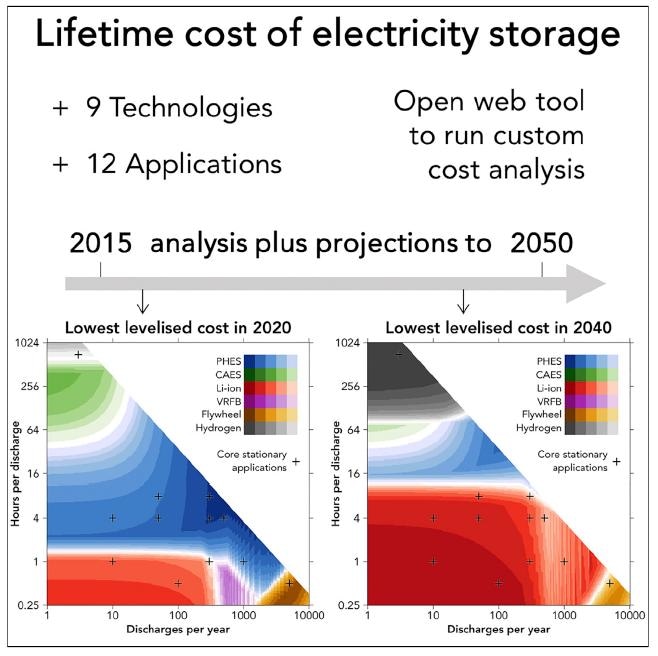Jan 10 2019
When it comes to buying or leasing a car, the sticker price and the long-term frequent costs, like gas and maintenance, have to be taken into consideration.
 This visual abstract depicts an analysis of 9 energy storage technologies between 2015 and 2050. (Image credit: Schmidt et al./Joule)
This visual abstract depicts an analysis of 9 energy storage technologies between 2015 and 2050. (Image credit: Schmidt et al./Joule)
According to researchers at Imperial College London, a similar analysis is required when deciding how to make investments in clean energy storage. Therefore, a new model was developed by the researchers to establish the lifetime expenses of 9 electricity storage technologies for 12 varied applications between the years 2015 and 2050.
This unique model, which estimates lithium-ion batteries to be the most inexpensive technology in the coming years, has been featured in the journal Joule on January 9th, 2019 and is available open access.
“We have found that lithium-ion batteries are following in the footsteps of crystalline silicon solar panels,” stated senior author Iain Staffell (@iain_staffell), a lecturer from the Centre for Environmental Policy at Imperial College London. “Lithium-ion batteries were once expensive and suited only to niche applications, but they are now being manufactured in such volumes, their costs are coming down much faster than the competing storage technologies.”
Incorporating data from over 30 peer-reviewed studies, the model reveals that currently, pumped-storage hydroelectricity is the cheapest energy storage mechanism, in which spare energy is used to pump water to a higher elevation and subsequently discharged to harvest the energy when required.
Conversely, as time progresses, the costs related to pumped-storage hydroelectricity do not reduce, while the costs related to lithium-ion battery considerably reduce, rendering them the most inexpensive option for the majority of applications from 2030.
Personally, I was always quite skeptical toward lithium-ion storage for stationary applications, but when it comes to the levelized cost of storage—investment, operation and charging cost, technology lifetime, efficiency and performance degradation—lithium-ion combines decreasing cost with sufficient performance to dominate the majority of power system applications. I would have expected others to outperform in certain applications.
Oliver Schmidt, PhD Researcher and Study First Author, Imperial College London
Schmidt is also the founder of Storage Lab.
He added that the new model does not necessarily reveal anything about whether lithium-ion batteries are the most ideal technology for stationary storage; however, since it has a good head start in the market, it is perfectly poised to become the most economical option in the near future.
While the investigators cannot predict how novel materials or developments will affect the market, they do believe that their model, which is available open access to test a wide range of technology cost and performance assumptions, can currently aid policymakers and industry to make informed investment decisions.
The authors received funding from the Grantham Institute—Climate Change and the Environment at Imperial College London, and the Engineering and Physical Sciences Research Council.